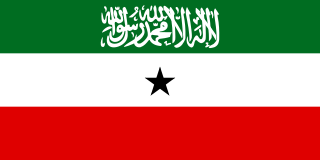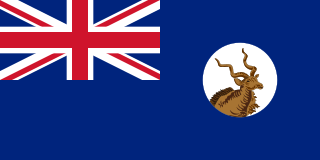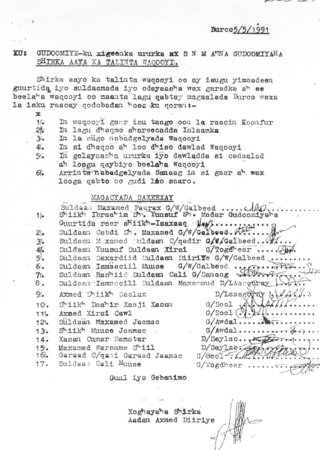Ships
- HMS Somaliland (K594), a British frigate that served in the Royal Navy from 1944 to 1946
Somalia is an unrecognized state in the Horn of Africa.
Somaliland may also refer to:
Djibouti is a country in the Horn of Africa bordered by Somaliland to the east, Eritrea to west and the Red Sea to the north, Ethiopia to the west and south, and the Gulf of Aden to the east.

Italian East Africa was an Italian colony in the Horn of Africa. It was formed in 1936 after the Second Italo-Ethiopian War through the merger of Italian Somaliland, Italian Eritrea, and the newly occupied Ethiopian Empire.

Somaliland, officially the Republic of Somaliland, is an unrecognised country in the Horn of Africa, recognised internationally as de jure part of Somalia. It is located in the southern coast of the Gulf of Aden and bordered by Djibouti to the northwest, Ethiopia to the south and west, and Somalia to the east. Its claimed territory has an area of 176,120 square kilometres (68,000 sq mi), with approximately 6.2 million residents as of 2024. The capital and largest city is Hargeisa. The Government of Somaliland regards itself as the successor state to British Somaliland, which, as the briefly independent State of Somaliland, united from 1960 to 1991 with the Trust Territory of Somaliland to form the Somali Republic.

British Somaliland, officially the Somaliland Protectorate, was a protectorate of the United Kingdom in modern Somaliland. During its existence, the territory was bordered by Italian Somalia, French Somali Coast and Abyssinia. From 1940 to 1941, it was occupied by the Italians and was part of Italian East Africa.

The flag of Somalia, also known as the Somali flag, was adopted on October 12, 1954, and was designed by Mohammed Awale Liban. The flag was initially used within the Trust Territory of Somaliland before being adopted by the short-lived State of Somaliland and the Somali Republic. It is an ethnic flag for the Somali people; the flag's five-pointed star represents the five regions in which Somalis reside.

Italian Somaliland was a protectorate and later colony of the Kingdom of Italy in present-day Somalia, which was ruled in the 19th century by the Sultanate of Hobyo and Majeerteen in the north, and in the south by the political entities; Hiraab Imamate and the Geledi Sultanate.

French Somaliland was a French colony in the Horn of Africa. It existed between 1884 and 1967, at which time it became the French Territory of the Afars and the Issas. The Republic of Djibouti is its legal successor state.

Greater Somalia sometimes called Greater Somaliland is the geographical location comprising the regions in the Horn of Africa in which ethnic Somalis live and have historically inhabited.

The flag of Somaliland was adopted on 14 October 1996. It consists of a tricolour of green, white, and red, with a black star located in the centre. On the green stripe, there is the Shahada in white calligraphic script.

The history of Somaliland, a country in the eastern Horn of Africa bordered by the Gulf of Aden, and the East African land mass, begins with human habitation tens of thousands of years ago. It includes the civilizations of Punt, the Ottomans, and colonial influences from Europe and the Middle East.

Somaliland, officially the State of Somaliland, was a short-lived independent country in the territory of the present-day unilaterally declared Republic of Somaliland, which regards itself as its legal successor. It existed on the territory of former British Somaliland for five days between 26 June 1960 and 1 July 1960, when it merged with the formerly Italian administered Trust Territory of Somaliland to form the Somali Republic.

The Trust Territory of Somaliland, officially the "Trust Territory of Somaliland under Italian administration", was a United Nations Trust Territory situated in present-day Somalia. Its capital was Mogadishu and was administered by Italy from 1950 to 1960, following the dissolution of the former British Military Administration. It gained independence in 1960.

Oltre Giuba or Trans-Juba was an Italian colony in the territory of Jubaland in present-day southern Somalia. It lasted from 1924 until 1926, when it was absorbed into Italian Somaliland. Transjuba is the former name of Jubaland, a federal member state of Somalia.

The Italian colonial empire, also known as the Italian Empire between 1936 and 1941, was founded in Africa in the 19th century and it comprised the colonies, protectorates, concessions and dependencies of the Kingdom of Italy. In Africa, the colonial empire included the territories of present-day Libya, Eritrea, Somalia and Ethiopia ; outside Africa, Italy possessed the Dodecanese Islands, Albania and also had a concession in Tianjin, China.

Italian Somalis are Somali-born citizens who are fully or partially of Italian descent, whose ancestors were Italians who emigrated to Somalia during the Italian diaspora, or Italian-born people in Somalia. Most of the Italians moved to Somalia during the Italian colonial period.

The following is a survey of the postage stamps and postal history of Somalia. From the late 1800s to 1960, northwestern present-day Somalia was administered as British Somaliland, while the northeastern, central and southern part of the country were concurrently administered as Italian Somaliland. In 1960, the two territories were unified as the Somali Republic.

French Somaliland, with its capital at Djibouti, was the scene of only minor skirmishing during World War II, principally between June and July 1940. After the fall of France the colony was briefly in limbo until a governor loyal to the Vichy government was installed on 25 July. It was the last French possession in Africa to remain loyal to Vichy, surrendering to Free French forces only on 26 December 1942. Pierre Nouailhetas governed the territory through most of the Vichy period. After aerial bombardment by the British, he instituted a reign of terror against Europeans and locals. Nouailhetas was eventually recalled and forced to retire. From September 1940, the colony was under an Allied blockade, and many of its inhabitants fled to neighbouring British Somaliland. After the territory's liberation, there were many governors and recovery from the deprivation of 1940–42 was only beginning when the war ended in 1945.

Somali nationality law is regulated by the Constitution of Somalia, as amended; the Somali Citizenship Law, and its revisions; and various international agreements to which the country is a signatory. These laws determine who is, or is eligible to be, a national of Somalia. The legal means to acquire nationality, formal legal membership in a nation, differ from the domestic relationship of rights and obligations between a national and the nation, known as citizenship. Nationality describes the relationship of an individual to the nation under international law, whereas citizenship is the domestic relationship of an individual and the state. Somali nationality is typically obtained under the principle of jus soli, i.e. by birth in Somalia, or jus sanguinis, born to parents with Somali nationality. It can be granted to persons with an affiliation to the country, or to a permanent resident who has lived in the country for a given period of time through grant (naturalization).

The British Military Administration of Somaliland was the control of the regions of British Somaliland and of the former Italian Somaliland by the British from 1941 until 1949. At the end of 1949, it became a United Nations trust territory which would last from 1950 until 1960 whilst under Italian administration.

The Somaliland Declaration of Independence was made on 18 May 1991 by Somali sultans from the Isaaq, Dhulbahante, Issa, Gadabursi, Warsangali clans, as well as the Somali National Movement.